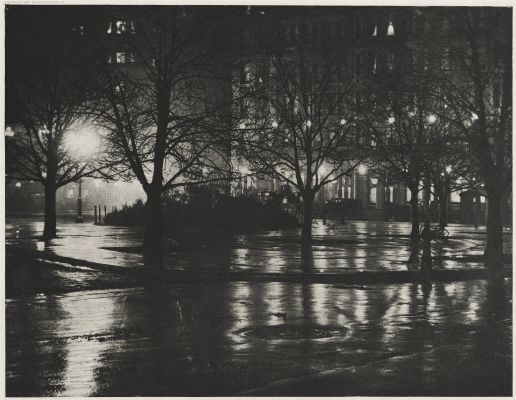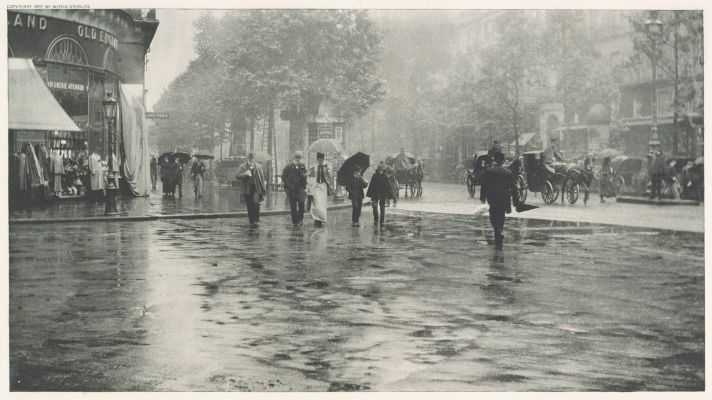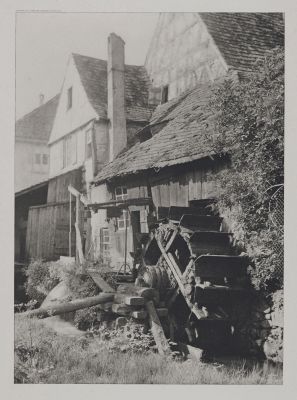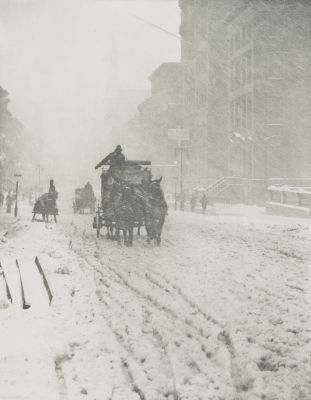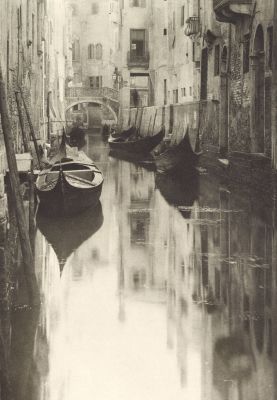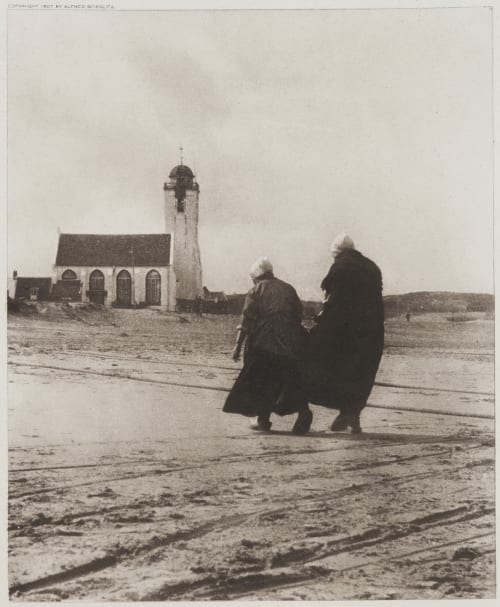
Title
Scurrying HomeArtist
Stieglitz, Alfred (American, 1864-1942)Key FigurePublication
Picturesque Bits of New York and Other StudiesDate
1897Process
PhotogravureAtelier
Alfred Stieglitz (film positive)Image Size
18 x 14.8 cmSheet Size
32.5 x 25 cm
The art critic Sadakichi Hartmann best described this image: "Scurrying Home could teach many an artist what composition means . . . . Two Dutch women crossing an open waste of sand, with the Katwyk Church, made famous by modern painters, in the distance. How interesting the texture of the foreground! How well its oblique lines cut those of the middle distance! How well the distance is managed! And how marvelously the figures are placed, considering that if they had been photographed one second sooner or later the picture would have been spoiled. Their movement is as natural as it can be; it suggests the breeziness of the weather… Scurrying Home is a landmark in the domain of camera art and … shows better than any other American photograph I know the possibilities of artistic photography." The location is Katwijk aan Zee a seaside resort located on the North Sea at the mouth of the Oude Rijn in the municipality of Katwijk and the province of South Holland.
A landmark in photogravure and photography as fine art.
It was during Stiegitz’s years as editor of Camera Notes that he began exploring the artistic possibilities of photogravure. In 1897, the very year that Camera Notes commenced, the prestigious publisher R. H. Russell issued Picturesque Bits of New York and Other Stories, a portfolio of twelve of Stieglitz’s best-known early images printed as oversized photogravures. So important was this project to Stieglitz, that he personally made the transparencies used in plate making, and then supervised the printing of the entire edition of photogravures. So pleased was he with the results that he signed a limited deluxe edition of the portfolio and allowed the photogravures to be sold individually. Stieglitz felt these prints had high-art value and were no less intrinsically works of art because they were printed by photogravure. Such photogravures joined the great tradition of fine printmaking established by artists like Durer and Rembrandt. [1]
We have been accustomed to see the fine tones and graduations of our best workers so utterly ruined in the process of engraving and printing that we are agreeably surprised at the wonderful delicacy and transparency of these examples. They are printed on heavy plate paper, 14×17 inches, and each plate is presented in a color appropriate to the subject. We might take exception to the tint employed in the “Glow of Night,” where the desire to reproduce the yellow glare of the incandescent and other lights glowing through the fog and mist of a rainy night on Fifth Avenue has led to the employment of colors that are singularly disagreeable. Perhaps our photographic experience heightens this repugnance, because the tones, ranging from yellow to a somewhat dirty greenish black, recall the effect of an aristotype badly sulphurized in a combined toning and fixing bath. It is possible that the print will be more satisfactory to an artist, or to an art lover, who has never dabbled in photography. In all the other cases the colors are admirably chosen. [2]
The photogravures were printed in an edition of twenty-five on plate paper using different ink colors. Stieglitz himself made the steel engravings from the diapositives (positives made from negatives) and used rapid plates to preserve the detail and softness of the originals. In addition, he directly supervised the printing of each image. Picturesque New York was apparently an earlier title of the portfolio. [3]
The pictures vibrate with atmosphere–fog, snow, streetlights reflected on wet pavements. The word “bits” suggests fleeting impressions caught by a highly selective eye, the crystallization of experience similar to the effects sought by Ezra Pound and Hilda Doolittle in the Imagistic poetry they would invent in the next decade. [4]
A two-page advertisement for the portfolio appeared in a small catalogue issued by publisher RH Russell in 1897 stating specifics for the portfolio as well as photographs, which Stieglitz sold individually. The twelve subjects, together with an introduction by W.E. Woodbury, are issued in an artistic portfolio. Price, $10.00 There will also be an Edition-De-Luxe in a special binding, limited to forty copies of the first impressions, each plate signed by Mr. Stieglitz. Price, $25.00 Single Proofs of any of the plates. Price, $2.00, each. Artist’s Proofs, signed by Mr. Stieglitz. Price, $5.00, each.
Even with this marketing push by RH Russell as well as others, it is doubtful that many of the Picturesque Bits portfolios were sold, especially the $25.00 Edition-De-Luxe edition signed by Stieglitz. Book seller catalogues around the turn of the 20th century remaindered original $10.00 “ordinary” copies of the portfolio to $5.00. The now accepted total copies of this seminal portfolio in the history of photography numbers a mere 25 copies: “The photogravures were printed in an edition of twenty-five on plate paper using different ink colors.” [5]
Reproduced / Exhibited
Greenough, Sarah, and Alfred Stieglitz. Alfred Stieglitz: The Key Set : the Alfred Stieglitz Collection of Photographs. Washington, D.C: National Gallery of Art, 2002. Pl 218
link:https://www.nga.gov/collection/art-object-page.35354.html
Exhibited: The Camera Club, New York, “Exhibition of Photographs by Alfred Stieglitz,” 1–15 May, 1899 NY
Hartmann, Sadakichi. Landscape and Figure Composition. New York: The Baker and Taylor Company, 1910. fig. 114
Homer, William I, Catherine Johnson, and Alfred Stieglitz. Stieglitz and the Photo-Secession, 1902. London: Penguin Putnam, 2002
Stieglitz, Alfred, Richard Whelan, and Sarah Greenough. Stieglitz on Photography: His Selected Essays and Notes. New York, NY: Aperture Foundation, 2000. p. 56
Hoffman, Katherine. Stieglitz: A Beginning Light. New Haven: Yale University Press, 2004. no. 153
Jussim, Estelle. Slave to Beauty: The Eccentric Life and Controversial Career of F. Holland Day, Photographer, Publisher, Aesthete. Boston: Godine, 1981. p. 95
Homer, William I. Alfred Stieglitz and the American Avant-Guarde. Boston: New York Graphic Society, 1979. no. 6.
Photography: the first eighty years, Colnaghi, London, 1976, pg 212 New York Graphic Society, New York, 1977, pg 18
References
[1] Peterson Christian A et al. Alfred Stieglitz’s Camera Notes. 1st ed. Published by the Minneapolis Institute of Arts in Association with W.W. Norton 1993.
[2] William M. Murray, “Reviews and Exchanges: ‘Picturesque Bits of New York, and Other Studies,’” Camera Notes 1 (January 1898), 84–85.
[3] Lunn Photo-Secession: Catalogue 6 [exh. cat., Lunn Gallery, Graphics International Ltd.] (Washington, 1977), 124–125.
[4] Trachtenberg, Alan; Reading American photographs: Images as History: Mathew Brady to Walker Evans: 1989: Hill and Wang: New York: p. 184
[5] https://www.nga.gov/research/online-editions/alfred-stieglitz-key-set/portfolios-and-published-photographs.html
Alfred Stieglitz | The Key Set: The Alfred Stieglitz Collection of Photographs: Volume Two 1923-1937: Sarah Greenough: National Gallery of Art, Washington| Harry N. Abrams, Inc. : 2002: p. 937
https://photoseed.com/collection/group/picturesque-bits-of-new-york-and-other-studies/ (cited Oct. 11, 2022)


